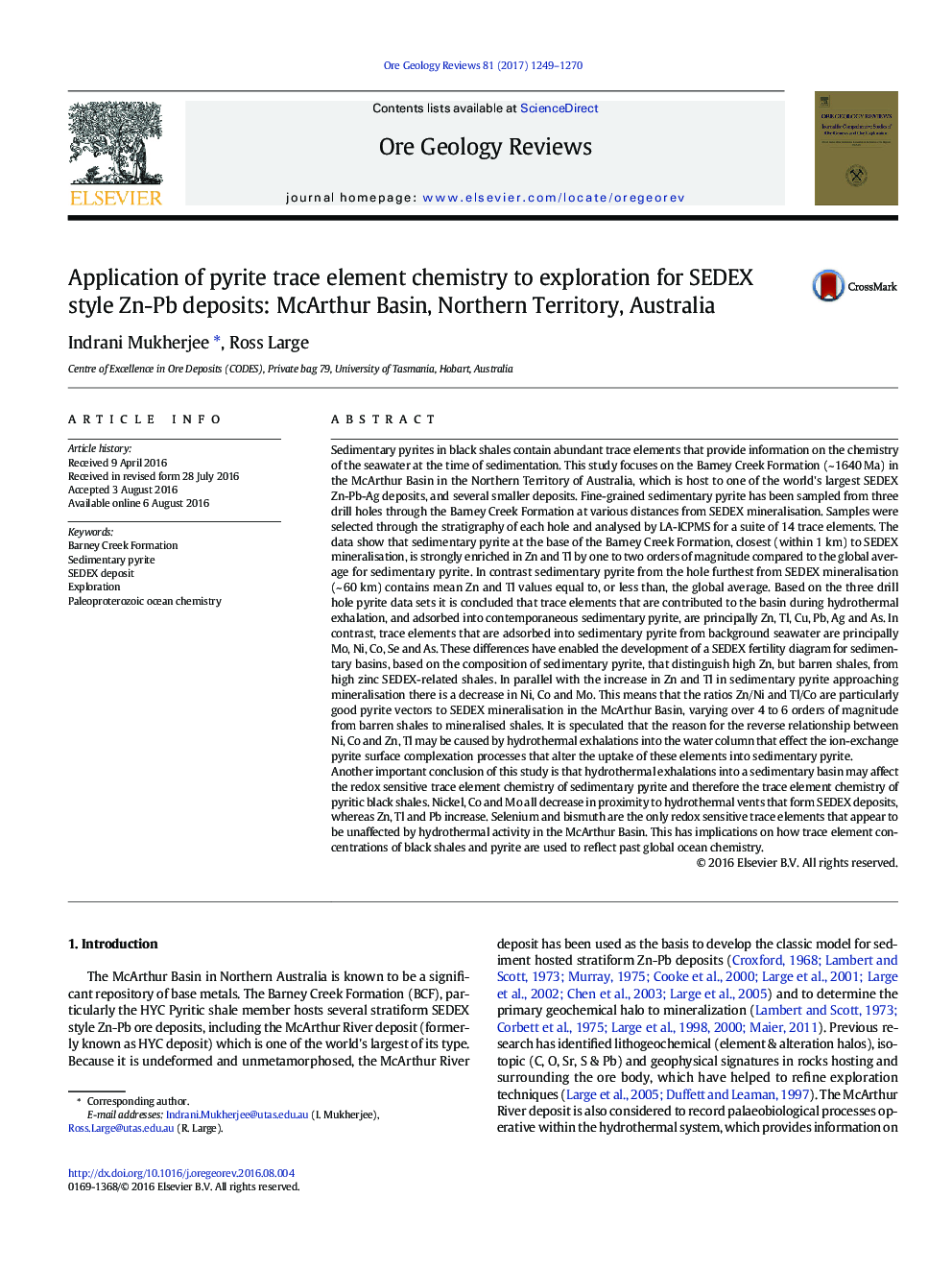| کد مقاله | کد نشریه | سال انتشار | مقاله انگلیسی | نسخه تمام متن |
|---|---|---|---|---|
| 5782522 | 1413924 | 2017 | 22 صفحه PDF | دانلود رایگان |

- Trace element content (& their ratios) of sedimentary pyrite in the Barney Creek Formation was studied using LA-ICP-MS.
- Pyrite trace element patterns assists in exploration of SEDEX deposits (high Zn, Tl & low Ni, Co in mineralised shales).
- Variability of redox sensitive elements in mineralised black shales cannot be used to interpret Paleoocean chemistry.
Sedimentary pyrites in black shales contain abundant trace elements that provide information on the chemistry of the seawater at the time of sedimentation. This study focuses on the Barney Creek Formation (~Â 1640Â Ma) in the McArthur Basin in the Northern Territory of Australia, which is host to one of the world's largest SEDEX Zn-Pb-Ag deposits, and several smaller deposits. Fine-grained sedimentary pyrite has been sampled from three drill holes through the Barney Creek Formation at various distances from SEDEX mineralisation. Samples were selected through the stratigraphy of each hole and analysed by LA-ICPMS for a suite of 14 trace elements. The data show that sedimentary pyrite at the base of the Barney Creek Formation, closest (within 1Â km) to SEDEX mineralisation, is strongly enriched in Zn and Tl by one to two orders of magnitude compared to the global average for sedimentary pyrite. In contrast sedimentary pyrite from the hole furthest from SEDEX mineralisation (~Â 60Â km) contains mean Zn and Tl values equal to, or less than, the global average. Based on the three drill hole pyrite data sets it is concluded that trace elements that are contributed to the basin during hydrothermal exhalation, and adsorbed into contemporaneous sedimentary pyrite, are principally Zn, Tl, Cu, Pb, Ag and As. In contrast, trace elements that are adsorbed into sedimentary pyrite from background seawater are principally Mo, Ni, Co, Se and As. These differences have enabled the development of a SEDEX fertility diagram for sedimentary basins, based on the composition of sedimentary pyrite, that distinguish high Zn, but barren shales, from high zinc SEDEX-related shales. In parallel with the increase in Zn and Tl in sedimentary pyrite approaching mineralisation there is a decrease in Ni, Co and Mo. This means that the ratios Zn/Ni and Tl/Co are particularly good pyrite vectors to SEDEX mineralisation in the McArthur Basin, varying over 4 to 6 orders of magnitude from barren shales to mineralised shales. It is speculated that the reason for the reverse relationship between Ni, Co and Zn, Tl may be caused by hydrothermal exhalations into the water column that effect the ion-exchange pyrite surface complexation processes that alter the uptake of these elements into sedimentary pyrite.Another important conclusion of this study is that hydrothermal exhalations into a sedimentary basin may affect the redox sensitive trace element chemistry of sedimentary pyrite and therefore the trace element chemistry of pyritic black shales. Nickel, Co and Mo all decrease in proximity to hydrothermal vents that form SEDEX deposits, whereas Zn, Tl and Pb increase. Selenium and bismuth are the only redox sensitive trace elements that appear to be unaffected by hydrothermal activity in the McArthur Basin. This has implications on how trace element concentrations of black shales and pyrite are used to reflect past global ocean chemistry.
Journal: Ore Geology Reviews - Volume 81, Part 4, March 2017, Pages 1249-1270